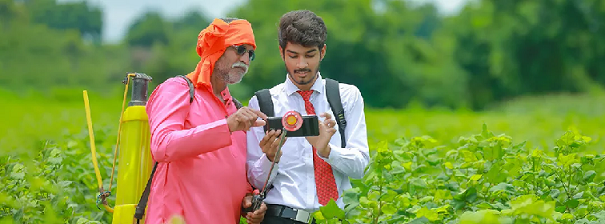What is the Future of Agriculture in India?

As for India, 70% of the country is dependent on Agriculture. Though we’ve all moved into different lifestyles, agriculture still is the backbone of the nation. Agriculture is one of India’s most important industries, with a market value of USD 370 billion. According to the latest Economic Survey – the agriculture sector’s GDP contribution is expected to increase. With supportive regulations and established farming methods – the govt has taken major strides to assist and strengthen the sector over the past years.
The most recent advancement of digital technology in agriculture will help to accelerate growth by ensuring higher crop yields and improving sustainability by lowering water consumption and pesticide use.
Key Trends that are Expected for the Agriculture Industry
- There will be greater research, technological advancements, and protected growing of high-value greens and other vegetables. Processed and reasonably priced high-quality items will be in higher demand.
- Changing demand as a result of rising earnings, globalization, and increased health consciousness is affecting and will continue to affect output in the future. Future demand for fruits and vegetables, dairy products, seafood, and meat will rise.
- There would be higher competition among private enterprises to provide novel products, better seeds, fertilizers, plant protection chemicals, tailored farm machinery, and animal feed, among other things, at cost-effective pricing, allowing farmers to receive a greater return on investments.
- Biotechnology and breeding will be critical in generating environmentally friendly and disease-resistant crop varieties that are also more nutritious and tasty.
- India’s internet connectivity has greatly improved, and market access has become easier. In 2025, the number of internet users is expected to rise to 666.4 million. Farmers will act more intelligently with mobile phones in their hands and will be more aware of and connected to many stakeholders. The govt will make great use of digital technology to raise farmer awareness, share information, and implement government initiatives that leverage digital technology for direct money transfers. Also, with online sources – we could also see agriculture sector stocks in India getting more popular.
- Some technologies will become more prevalent and extensively used in the future, and some will mature quickly while others will take longer. To produce the same items in a different way, prudently using resources and incorporating new resources such as hydroponics and the use of plastics and bioplastics in production. There will be more vertical and urban farming, as well as long-term initiatives to identify new agricultural places such as barren deserts and seas.
- Use nanotechnology to improve food quality and safety; efficient input use will be possible in the near future. In agriculture, nanomaterials will reduce chemical waste, reduce nutrient losses in fertilization, and be used to boost output through insect and nutrient management.
- Precision farming will be focused on exact application inputs in agriculture, including soil testing-based decisions and automation using artificial intelligence. Sensors and drones will be employed for cost-effective precision, quality, and environmental monitoring.
- The government, village communities, agricultural entrepreneurs, and commercial actors will all work harder to conserve the rapidly decreasing water resource. Digital technology has the potential to revolutionize this field. Satellites, IoT, and drones will be used to collect data on soil health, crop area, and yield, lowering insurance costs by improving estimations and making the system more precise and effective.
- There will be more specialty marketers in operations, area, and crop-specific small equipment, making operations easier and more efficient even on small farms.
- Food waste will be reduced, and agricultural waste will be better utilized. The number of private warehouses will grow, and the number of links between government and private warehouses will grow. This will aid in balancing supply and demand and stabilizing agri-output prices on the market.
- Agriculture retail will be largely digitized. According to a study, by 2025, more than 90% of Kirana stores in the country will be digitized, with contemporary traceable logistics and a transparent supply chain. Many businesses, such as Amazon and more, have already brought Kirana stores to consumers’ doorsteps.
But, there could be some constraints to the agriculture industry of our country, you see. Let’s talk about them to look at the bigger picture – and also get a bird’s view.
What are the Constraints to the Agriculture Industry
Micro land holdings: In India, farming is afflicted by micro land holdings, which limit any farmer’s scope and scale to adopt mixed farming, switch to growing numerous crops at once, or even try out new ways to grow a crop.
Low credit supply: Farmers’ purchasing and selling decisions are influenced by their lack of access to credit and the prominence of unorganized creditors. Institutional credit requires the ownership of assets and income to assess a potential borrower’s creditworthiness. In the absence of such creditworthiness, access is denied.
Subsistence Agriculture: When crops fail, or livestock dies in subsistence agriculture, the farmer faces famine. Due to the fixed expenses of sowed crops and debt interest, losing even a percentage of the harvest or receiving low prices can easily result in negative cash flow.
Value-addition is less at the primary level: In comparison to wealthy countries, there is very little value addition and very little primary-level processing at the farmer’s level.
Low technology penetration: Less usage of technology, mechanization, and poor productivity, the first two of which are key concerns. While large farmers may easily accept new technologies, it is the penetration of the marginal sector that will make a difference. In India, the entire degree of mechanization is less than 50%, compared to 90% in affluent countries, and approximately 40% of the food produced is lost or squandered.
Irrigation Infrastructure Deficit: Farming infrastructure deficiency increases reliance on weather and marketing. To make economic operations sustainable, more than half of India’s land is reliant on rainfall during the monsoon season. However – extreme caution needs to be exercised to avoid the negative impacts of over-irrigation, particularly in canal-irrigated areas. Due to improper irrigation, large expanses of Punjab and Haryana (areas afflicted by salinity, alkalinity, and waterlogging) have been rendered worthless.
Soil depletion: For thousands of years, Indian soils have been utilized to raise crops with little regard for replenishment. As a result – soils have been depleted and exhausted, resulting in low productivity. Almost all crops have among the lowest average yields in the world. This is a severe issue that can be addressed by increasing the use of manures and fertilizers.
Farming as a viable source of income: future generations do not desire to continue in their parents’ footsteps, driving urbanization. Most farmers have no buffer ready in the event of a poor crop, whether due to wayward rainfall, pests, or other factors.
Inadequate storage facilities: In rural locations, storage facilities are either non-existent or woefully inadequate. The farmers would be forced to sell their produce soon after harvest at market prices, which are almost always poor.
Irrespective of all of these factors, what does the future hold for the agriculture industry? Here is your answer.
What Will the Future Hold for the Agriculture Sector?
Farmers may gather, visualize, and assess crop and soil health conditions at various phases of production using technological interventions such as remote sensing, soil sensors, unmanned aerial surveying, and market insights, among others. They would serve as an early warning to identify the possible problems and provide solutions in a timely manner.
AI/ML algorithms can create real-time actionable insights to help farmers enhance crop output, control pests, assist with soil screening, give actionable data, and minimize their labor.
Blockchain technology provides tamper-proof and exact data on farms and inventories, as well as fast and secure transactions and food tracking. Farmers no longer need to rely on papers or files to record and keep critical information.
To make digital agriculture successful in India, the following initiatives could be implemented: –
Technology with a low cost:- An Indian farmer’s average annual income is over 1,000 USD. This poor income reflects the fragile financial situation in which the average Indian farmer operates. As a result – cutting the cost of tech will be beneficial.
Portable Hardware:- Since most Indian farms are tiny, plug-and-play hardware has a better chance of succeeding in the Indian market. Agricultural land leasing is also pretty common under different farming agreements. So – the farmer who is cultivating on one plot of land may transfer to another plot for the next season. Farmers could be better off investing in some portable equipment in such situations.
Academic Support:- Farmers are regularly interacted with by local agricultural organizations and academic institutes through a variety of locally run programs and government initiatives. Farmers will be more likely to accept digital technology if multiple academic institutes and agricultural organizations provide training.
Renting and sharing the platform for agriculture equipment and machinery:- Due to the limited financial resources and small agricultural plots – the digital platforms that offer equipment renting and sharing services instead of outright purchases are becoming more famous.
Conclusion
We are on the verge of the agriculture industry adopting modern technologies like IoT and AI. With this – which we believe would not take long, we can hopefully believe the agriculture industry will take upturns.











